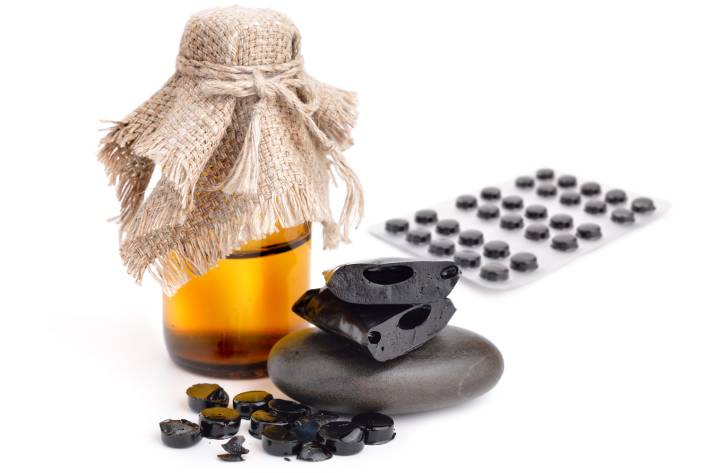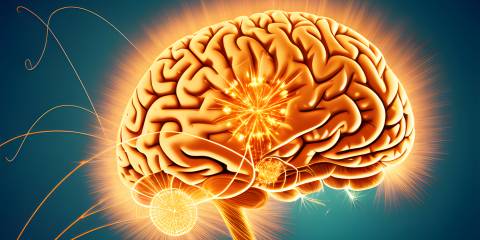Known as a rejuvenating herb in Ayurvedic medicine, shilajit has been popular for thousands of years in India. Today it’s gaining attention for its many health benefits.
What Is Shilajit?
Shilajit is fossilized plant remains found mostly in rock cracks. Sourced from the Himalayas but also from Russia, Afghanistan, Tibet, and Chile, shilajit forms from microbial matter and the gradual decomposition of plants over hundreds and sometimes thousands of years.
What's in Shilajit?
Brownish-black in color and hard and rock-like or sticky and tar-like, depending on its surrounding temperature and environment, shilajit is comprised mostly of humic substances (compounds formed during long-term decomposition).
-
Fulvic Acid
One of these substances is fulvic acid—a nutraceutical acting as an anti-inflammatory compound and antioxidant along with the humic acids.
-
Nitric Oxide
Shilajit’s thought to work by increasing the body’s levels of nitric oxide, a molecule that regulates inflammation, blood pressure, and blood sugar levels.
-
Trace Minerals
- calcium
- potassium
- magnesium
-
Other Nutrients
- sterols
- terpenoids
- flavonoids
What is Shilajit Used For?
Traditionally it was used by people in northern India and Nepal.
Sherpas, long known to have impressive longevity and strength, claimed to consume it as part of their diets.
For centuries, shilajit’s been used for:
- digestive disorders
- nervous issues
- anemia
- chronic bronchitis
- jaundice
- male infertility
- overall wellness
Shilajit’s Potential Benefits
-
Body
- Increased energy levels and physical stamina by supporting mitochondria—the cells’ energy powerhouses.
- Bone health: Shilajit is a source of phosphorus, magnesium, and calcium and may also support collagen production.
-
Mind
- Improved cognitive functioning and reduced inflammation in the brain.
- Lessened irritability, a calmer mind, and a reduction of anxiety due to shilajit’s anti-depressant properties.
-
Aging
- Slowing of the aging process.
- Help with cognitive issues, libido, and testosterone levels.
-
Heart / Blood
- Reduced heart disease risk due to shilajit’s antioxidant properties that slow aging, reduce cholesterol, and improve cell health.
- increased hemoglobin production to help with iron-deficiency anemia.
- Increased levels of glutathione—an antioxidant beneficial to the heart.
-
Gut
- Reduced growth of the harmful bacteria Helicobacter pylori in the gut.
- relief from stomach pain, flatulence, and constipation while supporting the health of the colon.
Clinical Studies
While there has not been a lot of research on shilajit to date:
- One study found that those who took it had a decrease in cholesterol and triglyceride levels compared to those who took a placebo.
- Another study reported that shilajit lessened chronic fatigue syndrome symptoms, since it reduced mental and physical stress.
Tips for Buying Shilajit
-
What to Look For
Some believe the benefits of shilajit vary depending on where it’s extracted. The Himalayan variety is considered to be the most authentic and “real” version, but purity is the most important consideration.
Purified, ready-to-consume products are essential when purchasing shilajit, as some items can be contaminated with heavy metals. Ensure the shilajit is tested for contaminants by an independent lab and is certified safe.
Shilajit should not be consumed in its unpurified and unprocessed form, as it can be toxic with possible chemical and physical impurities.
-
Choosing a Form
Available in tablets, capsules, powders, or resin, many prefer the powdered version as it can be easily added to smoothies, purified (not tap) water, or other beverages.
Powdered varieties allow for dosage customization. However, they may have a slightly lower amount of active compounds due to processing.
-
Storage
Shilajit can be stored at room temperature. On hot days, it may melt. Shilajit can also be refrigerated and will soften when returned to room temp.
How to Take Shilajit
-
Start Slowly
When taking shilajit, start slowly with a lower dose. Increase gradually, as needed, to help the body adjust and to reduce possible side effects.
-
Eat Before Taking
Take shilajit with food to prevent an upset stomach.
-
Keep Taking It
To experience its full benefits, take for at least three to six months.
Precautions
Experts believe it’s fine to consume shilajit on a regular basis, but it’s recommended to speak with a medical professional before routine intake to ensure it’s appropriate for your health needs.
Children and pregnant or breastfeeding women should avoid shilajit due to a lack of safety information on it for these individuals.
-
Possible Side Effects of Shilajit
- Side effects of shilajit can include diarrhea, vomiting, skin rash, and upset stomach, particularly when taken in large doses.
- As shilajit can cause energy bursts, it’s best to take it in the morning or earlier in the day.
-
Medical Interactions
- Shilajit can be taken with vitamins and other herbal supplements, but avoid supplementation within 2 hours of prescription medications as it may enhance their effects.
- Note that shilajit can interact with certain medicines such as blood thinners and diabetes medications.





